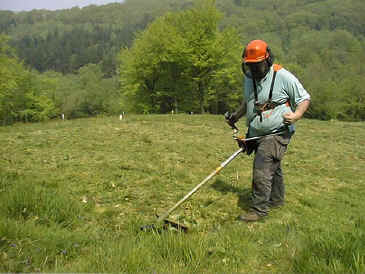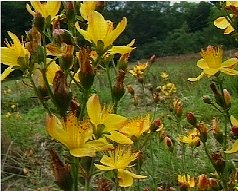The Effects of Management -
 17.
Brushcutting
17.
Brushcutting
a) General Effects
i) Grasses
The dominant plant species on the project site are grasses. Initially, Bents (Agrostis spp.) were dominant, but Yorkshire Fog (Holcus lanatus) has now overtaken them to become the most dominant species on the site (Table). This seems to be related to brushcutting. This relationship is indicated by the fact that the only areas where Yorkshire Fog is not dominant, are those which are not cut.
Brushcutting is non-selective and reduces all vegetation to ground level at regular intervals. This eliminates competition from species which would grow taller than the grass given time (Gorse, Heather, tree seedlings). If these are allowed to grow up, they outcompete the Yorkshire Fog and Bents and prevent them from becoming dominant. (However, they would also in time shade out the underlying developing heath vegetation.) More Information
ii) Tree seedlings
The most common tree seedlings on the site are Silver Birch (Betula pendula) and Cherry (Prunus sp.). Brushcutting controls their height, but not their distribution on the site. These two species appear to be in direct competition. Silver Birch is much more abundant, but Cherry grows more rapidly after cutting. Tree species are becoming dominant in the control section and in time will shade out the shorter vegetation. The only other area of the site where they are likely to be a problem is section 9 which is uncut. The management regime in this section allows for hand-weeding, so they can be controlled in this way when resources allow. More Information.
iii) Indirect effects
 Slender St. John’s Wort (Hypericum pulchrum) - (picture, left)
was widely distributed over the project site initially. It was the fourth most dominant
species in 1996 (Table). In subsequent years it has steadily
declined in abundance. This may be a direct result of brush cutting, or may be an indirect
effect, resulting from increased competiton with other species, particularly the grasses. More Information.
Slender St. John’s Wort (Hypericum pulchrum) - (picture, left)
was widely distributed over the project site initially. It was the fourth most dominant
species in 1996 (Table). In subsequent years it has steadily
declined in abundance. This may be a direct result of brush cutting, or may be an indirect
effect, resulting from increased competiton with other species, particularly the grasses. More Information.
b) Timing
Timing of the brush cut has shown a significant effect only on bluebells growing on the project site as a woodland remnant. The Bluebells are gradually being eliminated from sections 2 and 4 which are cut in the spring. The distribution of most other species on the site shows little relationship to the timing of brush cutting.
For an ecological sampling exercise, based on Bluebell distribution in strips 1 - 4 seven years after management on the Heathland Restoration site began, click here
c) Frequency
Cutting, whenever it takes place, will have the effect of reducing competition for light and space for a time. This may allow species to establish which would not otherwise be able to compete with the dominant plants. The more frequent the cutting, the more this effect is likely to be exaggerated. This is illustrated by the fact that Section 6, which is cut three times a year, had the highest species diversity on the project site. It was also the only area where annual plants became established.
As a consequence of the frequent cutting in section 6, Heather plants growing in this section have a quite different growth form. They form very low dense clumps, excluding other species because of the density of the canopy. As a result, Heather may come to dominate in this section in time, because it is likely to outcompete other species through its sheer density.
18. Grass Control
The initial application of Kerb Granules to section 7 for specific grass control prevented grasses from becoming dominant in this section in 1996 and 1997 (Table). However, the initial effects are now wearing off and grasses are increasingly dominant. Common Bent (Agrostis capillaris) rather than Yorkshire Fog (Holcus lanatus)is now the dominant grass in this section (Table). Sedges have a relatively high % cover in section 7. This may be related to the decrease in competition with grasses for space.
Continue to points 19-26| Heathland Restoration Project Report | ||||
Other Lowland Heaths in East Devon
